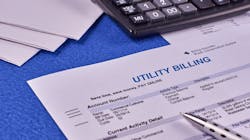Expanding Customer Payment Options: A Pandemic Response but Lasting Trend
While the COVID-19 pandemic began as — and remains — a health crisis, financial effects quickly followed for utility customers. For many, shelter-in-place orders limited access to in-person payment portals, and for those impacted by the rise in unemployment and a sudden inability to pay their bills, difficult choices had to be made. In fact, according to Fiserv Expectations & Experiences research, 23% of consumers surveyed in July reported having to choose which bills to pay because of financial stress.
In the face of this, utilities had two big priorities — maintaining critical cash flow and supporting their customers through the financial (and other) challenges brought on by the pandemic. To help customers navigate the impacts of COVID-19, utilities needed to rethink their payment strategies — offsetting some of the financial burdens while expanding options for bill payment.
Paperless in the Pandemic
One of the immediate effects of the pandemic was an acceleration of consumer preference for digital. Forward-thinking utilities evolved touchpoints around billing and payment, quickly digitizing and expanding bill payment options for customers to pay online.
A bill payment option utilities are increasingly turning to is mobile bill presentment. It involves sending a digitized bill to a customer's smartphone, which they can pay with their mobile wallet. This is different from but complementary to mobile bill pay, which is a hosted solution through a utility's website that allows customers to pay through a mobile app via phone or tablet.
And even though credit cards are widely used for payments of all types, some utilities were not offering that option at the start of the pandemic, believe it or not. These organizations quickly realized the need to add that capability into their suite of payment options for customers.
Bridging the Digital Divide
While many utilities saw their customers embrace digital payment options, many were still what we call "cash preferred" — they either didn't want to or were unable to take advantage of the explosion of electronic payment options.
For utilities that had to close their walk-up windows because of mandated lockdowns, this removed a critical path to payment for many of their customers. Fortunately, many utilities were already offering in-person payment options through a network of retailers that accept cash payments at thousands of locations across the country. To lessen the burden on those walk-in customers, many utilities turned off the customer convenience fee normally charged when customers pay their bills that way. And they made it happen virtually overnight.
This ongoing demand for walk-in bill pay options, even as we see an accelerated rate of digital adoption, underscores the importance of utilities supporting their customers in how, when, and even where they want to pay their bills for the foreseeable future.
Resetting Customer Service and Payment Landscapes
At the outset of the pandemic, many utilities quickly did the right thing by suspending service shutoffs for customers in arrears, creating payment plans to help customers weather the crisis, and, in many cases, proactively reaching out to support at-risk customers.
Now, as the pandemic continues to disrupt lives, consumers are facing longer-term personal and financial distress. It's more important than ever for utilities to take stock of their billing and payment strategies to ensure they are aligned with the rapidly changing needs of their customers.
It's an opportune moment to drive consumer digital adoption while maintaining in-person payment options, given these key trends:
- Mobile consumers are relying more on credit, with over 24% of consumers saying they will be increasing their credit card usage over the next six months.
- Consumers want choices on where to access their digital bill, with 58% of consumers saying the ability to view their digital bill in multiple places (through a biller website, at their banks, and in a mobile wallet) was important.
- Consumers, who can, will switch from cash to digital payments, but 45% of consumers say it's important to them to have the ability to make in-person payments.
Looking Ahead
About the Author
Rob Houser
Senior Vice President, Product Management and Strategy, Biller Solutions, Fiserv
As Senior Vice President of Product Management and Strategy for Biller Solutions at Fiserv, Rob Houser has responsibility for governing product strategy, roadmap prioritization and product management functions. He also oversees relationships with key card brands, and processors on the merchant acquiring side of the business. Rob joined Fiserv in 2014 as CFO of Lending Solutions and later moved to Biller Solutions as CFO in 2017, responsible for financial planning and analysis, budgeting, forecasting and pricing functions. Prior to Fiserv, Rob spent 16 years in the healthcare industry at Merck, Bristol Myers Squibb, Firmenich and Integra LifeSciences where he held various roles as CFO, Controller and Investor Relations. With years of progressive experience in the financial services and healthcare industries, Rob is a well-respected thought leader, and is regularly covered in print and media publications across a range of industries. Rob has a MBA in Finance & Marketing and a B.S. in Accounting from Rider University.
